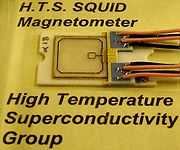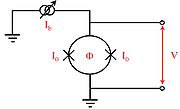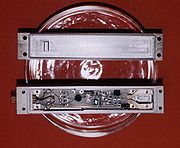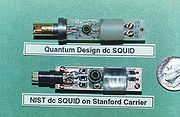
SQUID
Encyclopedia

Magnetometer
A magnetometer is a measuring instrument used to measure the strength or direction of a magnetic field either produced in the laboratory or existing in nature...
used to measure extremely weak magnetic field
Magnetic field
A magnetic field is a mathematical description of the magnetic influence of electric currents and magnetic materials. The magnetic field at any given point is specified by both a direction and a magnitude ; as such it is a vector field.Technically, a magnetic field is a pseudo vector;...
s, based on superconducting loops containing Josephson junctions.
SQUIDs are sensitive enough to measure fields as low as 5 aT
Tesla (unit)
The tesla is the SI derived unit of magnetic field B . One tesla is equal to one weber per square meter, and it was defined in 1960 in honour of the inventor, physicist, and electrical engineer Nikola Tesla...
(5×10−18 T) within a few days of averaged measurements. Their noise levels are as low as 3 f
Femto-
Femto- is a prefix in the metric system denoting a factor of 10−15 or . Adopted by the 11th Conférence Générale des Poids et Mesures, it was added in 1964 to the SI...
T·Hz
Hertz
The hertz is the SI unit of frequency defined as the number of cycles per second of a periodic phenomenon. One of its most common uses is the description of the sine wave, particularly those used in radio and audio applications....
-½. For comparison, a typical refrigerator magnet
Magnet
A magnet is a material or object that produces a magnetic field. This magnetic field is invisible but is responsible for the most notable property of a magnet: a force that pulls on other ferromagnetic materials, such as iron, and attracts or repels other magnets.A permanent magnet is an object...
produces 0.01 tesla (10−2 T), and some processes in animal
Animal
Animals are a major group of multicellular, eukaryotic organisms of the kingdom Animalia or Metazoa. Their body plan eventually becomes fixed as they develop, although some undergo a process of metamorphosis later on in their life. Most animals are motile, meaning they can move spontaneously and...
s produce very small magnetic fields between 10−9 T and 10−6 T. Recently invented SERF
SERF
A spin exchange relaxation-free magnetometer is a type of magnetometer developed at Princeton University in the early 2000s. SERF magnetometers measure magnetic fields by using lasers to detect the interaction between alkali metal atoms in a vapor and the magnetic field.The name for the technique...
atomic magnetometers are potentially more sensitive and do not require cryogenic refrigeration
Refrigeration
Refrigeration is a process in which work is done to move heat from one location to another. This work is traditionally done by mechanical work, but can also be done by magnetism, laser or other means...
but are orders of magnitude larger in size (~1 cm3) and must be operated in a near-zero magnetic field.
History and design
There are two main types of SQUID: direct currentDirect current
Direct current is the unidirectional flow of electric charge. Direct current is produced by such sources as batteries, thermocouples, solar cells, and commutator-type electric machines of the dynamo type. Direct current may flow in a conductor such as a wire, but can also flow through...
(DC) and radio frequency
Radio frequency
Radio frequency is a rate of oscillation in the range of about 3 kHz to 300 GHz, which corresponds to the frequency of radio waves, and the alternating currents which carry radio signals...
(RF). RF SQUIDs can work with only one Josephson junction, which might make them cheaper to produce, but are less sensitive.
DC SQUID


Brian David Josephson
Brian David Josephson, FRS is a Welsh physicist. He became a Nobel Prize laureate in 1973 for the prediction of the eponymous Josephson effect....
postulated the Josephson effect
Josephson effect
The Josephson effect is the phenomenon of supercurrent across two superconductors coupled by a weak link...
in 1962, and the first Josephson Junction was made by John Rowell and Philip Anderson at Bell Labs
Bell Labs
Bell Laboratories is the research and development subsidiary of the French-owned Alcatel-Lucent and previously of the American Telephone & Telegraph Company , half-owned through its Western Electric manufacturing subsidiary.Bell Laboratories operates its...
in 1963. It has two Josephson junctions in parallel in a superconducting loop. It is based on the DC Josephson effect. In the absence of any external magnetic field, the input current
 splits into the two branches equally. Now, consider if a small amount of external flux is applied to the superconducting loop. This results in the screening currents that generate the magnetic field to cancel this applied external flux. The current in one of the branches of the superconducting loop is in the direction of
splits into the two branches equally. Now, consider if a small amount of external flux is applied to the superconducting loop. This results in the screening currents that generate the magnetic field to cancel this applied external flux. The current in one of the branches of the superconducting loop is in the direction of  , and is equal to
, and is equal to  and in the second branch is in the opposite direction of
and in the second branch is in the opposite direction of  and is equal to
and is equal to  . As soon as the current in any one of the branches exceeds the critical current for the Josephson junction, a voltage appears across the junction. Now consider if the external flux is further increased and it now exceeds
. As soon as the current in any one of the branches exceeds the critical current for the Josephson junction, a voltage appears across the junction. Now consider if the external flux is further increased and it now exceeds  . Since the flux enclosed by the superconducting loop must be an integral number of the flux quanta, in this case the SQUID instead of screening the flux, energetically prefers to increase it to
. Since the flux enclosed by the superconducting loop must be an integral number of the flux quanta, in this case the SQUID instead of screening the flux, energetically prefers to increase it to  . The screening current now flows in the opposite direction. Thus the screening current changes direction every time the flux increases by half integer multiples of
. The screening current now flows in the opposite direction. Thus the screening current changes direction every time the flux increases by half integer multiples of  . Thus the critical current oscillates as a function of the applied flux. If the input current is more than
. Thus the critical current oscillates as a function of the applied flux. If the input current is more than  , then the SQUID always operates in the resistive mode. The voltage in this case is thus a function of the applied magnetic field and the period equal to
, then the SQUID always operates in the resistive mode. The voltage in this case is thus a function of the applied magnetic field and the period equal to  . Since the current-voltage characteristics of the DC SQUID is hysteretic, a shunt resistance,
. Since the current-voltage characteristics of the DC SQUID is hysteretic, a shunt resistance,  is connected across the junction to eliminate the hysteresis (in the case of copper oxide based high temperature superconductors the junction's own intrinsic resistance is usually sufficient). The screening current is the applied flux divided by the self inductance of the ring. Thus
is connected across the junction to eliminate the hysteresis (in the case of copper oxide based high temperature superconductors the junction's own intrinsic resistance is usually sufficient). The screening current is the applied flux divided by the self inductance of the ring. Thus  can be estimated as the function of
can be estimated as the function of  (flux to voltage converter) as follows:
(flux to voltage converter) as follows:- ∆V = R ∆I
- 2I = 2 ∆Φ/L, where L is the self inductance of the superconducting ring
- ∆V = (R/L) ∆Φ
RF SQUID

James Edward Zimmerman
James Edward Zimmerman was born in Lantry, South Dakota. He was a coinventor of the radio-frequency superconducting quantum interference device and he is credited with coining the term.- Career :...
at Ford. It is based on the AC Josephson effect and uses only one Josephson junction. It is less sensitive compared to DC SQUID but is cheaper and easier to manufacture in smaller quantities. The major part of fundamental measurements in biomagnetism even of extremely small signals have been performed, using RF SQUIDS (Tonotopic representation of the auditory cortex by Romani and Williamson 1980, brainstem auditory evoked magnetic field by Erné et al. 1987).
The RF SQUID is inductively coupled to a resonant tank circuit. Depending on the external magnetic field, as the SQUID operates in the resistive mode, the effective inductance of the tank circuit changes, thus changing the resonant frequency of the tank circuit. These frequency measurements can be easily taken, and thus the losses which appear as the voltage across the load resistor in the circuit are a periodic function of the applied magnetic flux with a period of Φ0. For a precise mathematical description refer to the original paper by Erné et al.
The traditional superconducting materials for SQUIDs are pure niobium
Niobium
Niobium or columbium , is a chemical element with the symbol Nb and atomic number 41. It's a soft, grey, ductile transition metal, which is often found in the pyrochlore mineral, the main commercial source for niobium, and columbite...
or a lead
Lead
Lead is a main-group element in the carbon group with the symbol Pb and atomic number 82. Lead is a soft, malleable poor metal. It is also counted as one of the heavy metals. Metallic lead has a bluish-white color after being freshly cut, but it soon tarnishes to a dull grayish color when exposed...
alloy
Alloy
An alloy is a mixture or metallic solid solution composed of two or more elements. Complete solid solution alloys give single solid phase microstructure, while partial solutions give two or more phases that may or may not be homogeneous in distribution, depending on thermal history...
with 10% gold
Gold
Gold is a chemical element with the symbol Au and an atomic number of 79. Gold is a dense, soft, shiny, malleable and ductile metal. Pure gold has a bright yellow color and luster traditionally considered attractive, which it maintains without oxidizing in air or water. Chemically, gold is a...
or indium
Indium
Indium is a chemical element with the symbol In and atomic number 49. This rare, very soft, malleable and easily fusible post-transition metal is chemically similar to gallium and thallium, and shows the intermediate properties between these two...
, as pure lead is unstable when its temperature is repeatedly changed. To maintain superconductivity, the entire device needs to operate within a few degrees of absolute zero
Absolute zero
Absolute zero is the theoretical temperature at which entropy reaches its minimum value. The laws of thermodynamics state that absolute zero cannot be reached using only thermodynamic means....
, cooled with liquid helium
Liquid helium
Helium exists in liquid form only at extremely low temperatures. The boiling point and critical point depend on the isotope of the helium; see the table below for values. The density of liquid helium-4 at its boiling point and 1 atmosphere is approximately 0.125 g/mL Helium-4 was first liquefied...
.
"High temperature" SQUID sensors are more recent; they are made of high temperature superconductors
High-temperature superconductivity
High-temperature superconductors are materials that have a superconducting transition temperature above . From 1960 to 1980, 30 K was thought to be the highest theoretically possible Tc...
, particularly YBCO
Yttrium barium copper oxide
Yttrium barium copper oxide, often abbreviated YBCO, is a crystalline chemical compound with the formula YBa2Cu3O7. This material, a famous "high-temperature superconductor", achieved prominence because it was the first material to achieve superconductivity above the boiling point of liquid...
, and are cooled by liquid nitrogen
Liquid nitrogen
Liquid nitrogen is nitrogen in a liquid state at a very low temperature. It is produced industrially by fractional distillation of liquid air. Liquid nitrogen is a colourless clear liquid with density of 0.807 g/mL at its boiling point and a dielectric constant of 1.4...
which is cheaper and more easily handled than liquid helium. They are less sensitive than conventional "low temperature" SQUIDs but good enough for many applications.
Uses

Magnetoencephalography
Magnetoencephalography is a technique for mapping brain activity by recording magnetic fields produced by electrical currents occurring naturally in the brain, using arrays of SQUIDs...
(MEG), for example, uses measurements from an array of SQUIDs to make inferences about neural
Neuron
A neuron is an electrically excitable cell that processes and transmits information by electrical and chemical signaling. Chemical signaling occurs via synapses, specialized connections with other cells. Neurons connect to each other to form networks. Neurons are the core components of the nervous...
activity inside brain
Human brain
The human brain has the same general structure as the brains of other mammals, but is over three times larger than the brain of a typical mammal with an equivalent body size. Estimates for the number of neurons in the human brain range from 80 to 120 billion...
s. Because SQUIDs can operate at acquisition rates much higher than the highest temporal frequency of interest in the signals emitted by the brain (kHz), MEG achieves good temporal resolution. Another area where SQUIDs are used is magnetogastrography
Magnetogastrography
Magnetogastrography is the science of recording magnetogastrograms . Magnetogastrograms are recordings of magnetic fields resulting from electrical activity from the stomach and can be considered similar to electrocardiograms. The magnetic fields are typically recorded using SQUIDs.-External links:*...
, which is concerned with recording the weak magnetic fields of the stomach. A novel application of SQUIDs is the magnetic marker monitoring
Magnetic marker monitoring
Magnetic marker monitoring is a method to monitor the passage of an orally applied drug through the intestinal tract. The dosage form is enriched with a small amount of magnetite , which then is magnetized by a high-energy magnetic field...
method, which is used to trace the path of orally applied drug
Drug
A drug, broadly speaking, is any substance that, when absorbed into the body of a living organism, alters normal bodily function. There is no single, precise definition, as there are different meanings in drug control law, government regulations, medicine, and colloquial usage.In pharmacology, a...
s. In the clinical environment SQUIDs are used in cardiology
Cardiology
Cardiology is a medical specialty dealing with disorders of the heart . The field includes diagnosis and treatment of congenital heart defects, coronary artery disease, heart failure, valvular heart disease and electrophysiology...
for magnetic field imaging
Magnetic field imaging
Magnetic Field Imaging is a non-invasive and side-effect-free cardiac diagnostic method. It detects and records the electromagnetic signals that are associated with the heartbeat using a multi channel magnetic sensor array. The electric signals are known from the ECG and recordings of the magnetic...
(MFI), which detects the magnetic field of the heart for diagnosis and risk stratification.
Probably the most common use of SQUIDs is in magnetic property measurement systems (MPMS). These are turn-key systems, made by several manufacturers, that measure the magnetic properties of a material sample. This is typically done over a temperature range from that of 4 K to roughly 190 K, though higher temperatures mean less precision.
For example, SQUIDs are being used as detectors to perform magnetic resonance imaging
Magnetic resonance imaging
Magnetic resonance imaging , nuclear magnetic resonance imaging , or magnetic resonance tomography is a medical imaging technique used in radiology to visualize detailed internal structures...
(MRI). While high field MRI uses precession fields of one to several teslas, SQUID-detected MRI uses measurement fields that lie in the microtesla regime. Since the MRI signal drops off as the square of the magnetic field, a SQUID is used as the detector because of its extreme sensitivity. The SQUID, coupled to a second-order gradiometer
Gradiometer
A gradiometer measures the gradient of a physical quantity, such as a magnetic field or gravity.-Types of gradiometer:There are at least two types of gradiometer to measure magnetic fields:...
and input circuit, along with the application of gradients, are the fundamental entities which allow a research group to retrieve noninvasive images. SQUID-detected MRI has advantages over high field MRI systems, such as the low cost required to build such a system, and its compactness. The principle has been demonstrated by imaging human extremities, and its future application may include tumor screening.
Another application is the scanning SQUID microscope
Scanning SQUID microscope
A Scanning SQUID Microscope is a sensitive near-field imaging system for the measurement of weak magnetic fields by moving a Superconducting Quantum Interference Device across an area. The microscope can map out buried current-carrying wires by measuring the magnetic fields produced by the...
, which uses a SQUID immersed in liquid helium
Helium
Helium is the chemical element with atomic number 2 and an atomic weight of 4.002602, which is represented by the symbol He. It is a colorless, odorless, tasteless, non-toxic, inert, monatomic gas that heads the noble gas group in the periodic table...
as the probe. The use of SQUIDs in oil
Petroleum
Petroleum or crude oil is a naturally occurring, flammable liquid consisting of a complex mixture of hydrocarbons of various molecular weights and other liquid organic compounds, that are found in geologic formations beneath the Earth's surface. Petroleum is recovered mostly through oil drilling...
prospecting
Prospecting
Prospecting is the physical search for minerals, fossils, precious metals or mineral specimens, and is also known as fossicking.Prospecting is a small-scale form of mineral exploration which is an organised, large scale effort undertaken by mineral resource companies to find commercially viable ore...
, mineral exploration
Mineral exploration
Mineral exploration is the process of finding ore to mine. Mineral exploration is a much more intensive, organized and professional form of mineral prospecting and, though it frequently uses the services of prospecting, the process of mineral exploration on the whole is much more involved.-Stages...
, earthquake
Earthquake
An earthquake is the result of a sudden release of energy in the Earth's crust that creates seismic waves. The seismicity, seismism or seismic activity of an area refers to the frequency, type and size of earthquakes experienced over a period of time...
prediction and geothermal energy surveying is becoming more widespread as superconductor technology develops; they are also used as precision movement sensors in a variety of scientific applications, such as the detection of gravitational wave
Gravitational wave
In physics, gravitational waves are theoretical ripples in the curvature of spacetime which propagates as a wave, traveling outward from the source. Predicted to exist by Albert Einstein in 1916 on the basis of his theory of general relativity, gravitational waves theoretically transport energy as...
s. Four SQUIDs were employed on Gravity Probe B
Gravity Probe B
Gravity Probe B is a satellite-based mission which launched on 20 April 2004 on a Delta II rocket. The spaceflight phase lasted until 2005; its aim was to measure spacetime curvature near Earth, and thereby the stress–energy tensor in and near Earth...
in order to test the limits of the theory of general relativity
General relativity
General relativity or the general theory of relativity is the geometric theory of gravitation published by Albert Einstein in 1916. It is the current description of gravitation in modern physics...
.
It has also been suggested that they might be implemented in a quantum computer
Quantum computer
A quantum computer is a device for computation that makes direct use of quantum mechanical phenomena, such as superposition and entanglement, to perform operations on data. Quantum computers are different from traditional computers based on transistors...
. These are the only macroscopic devices that have been cited as possible qubits in this context.
See also
- Josephson EffectJosephson effectThe Josephson effect is the phenomenon of supercurrent across two superconductors coupled by a weak link...
- Spallation Neutron SourceSpallation Neutron SourceThe Spallation Neutron Source is an accelerator-based neutron source facility that provides the most intense pulsed neutron beams in the world for scientific research and industrial development...
- Mineral explorationMineral explorationMineral exploration is the process of finding ore to mine. Mineral exploration is a much more intensive, organized and professional form of mineral prospecting and, though it frequently uses the services of prospecting, the process of mineral exploration on the whole is much more involved.-Stages...
- GeophysicsGeophysicsGeophysics is the physics of the Earth and its environment in space; also the study of the Earth using quantitative physical methods. The term geophysics sometimes refers only to the geological applications: Earth's shape; its gravitational and magnetic fields; its internal structure and...
- Electromagnetics
- Vibrating sample magnetometerVibrating sample magnetometerA vibrating sample magnetometer or VSM is a scientific instrument that measures magnetic properties, invented in 1955 by Simon Foner at Lincoln Laboratory MIT. The paper about his work was published shortly afterward in 1959 A sample is placed inside a uniform magnetic field to magnetize the sample...

